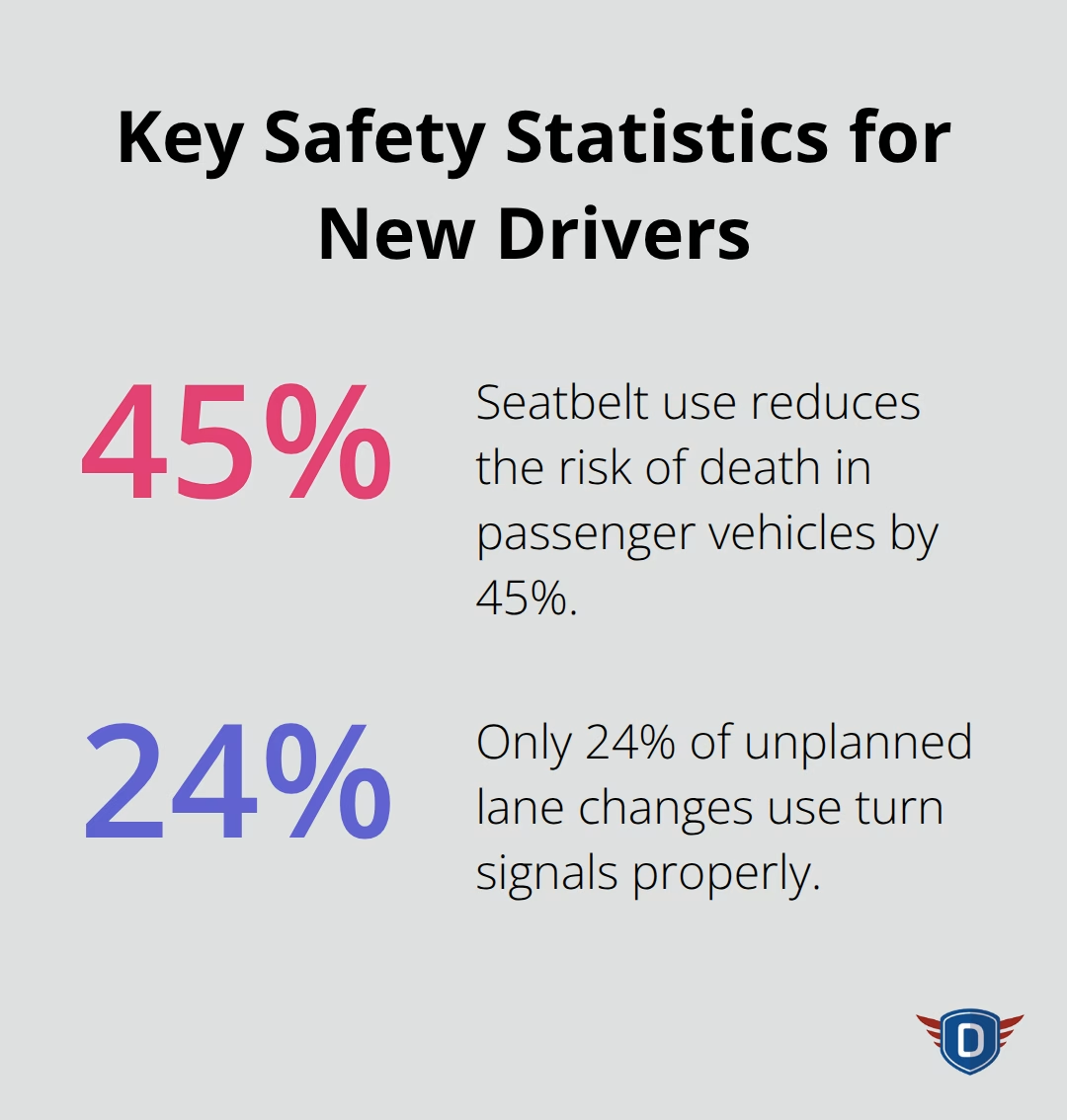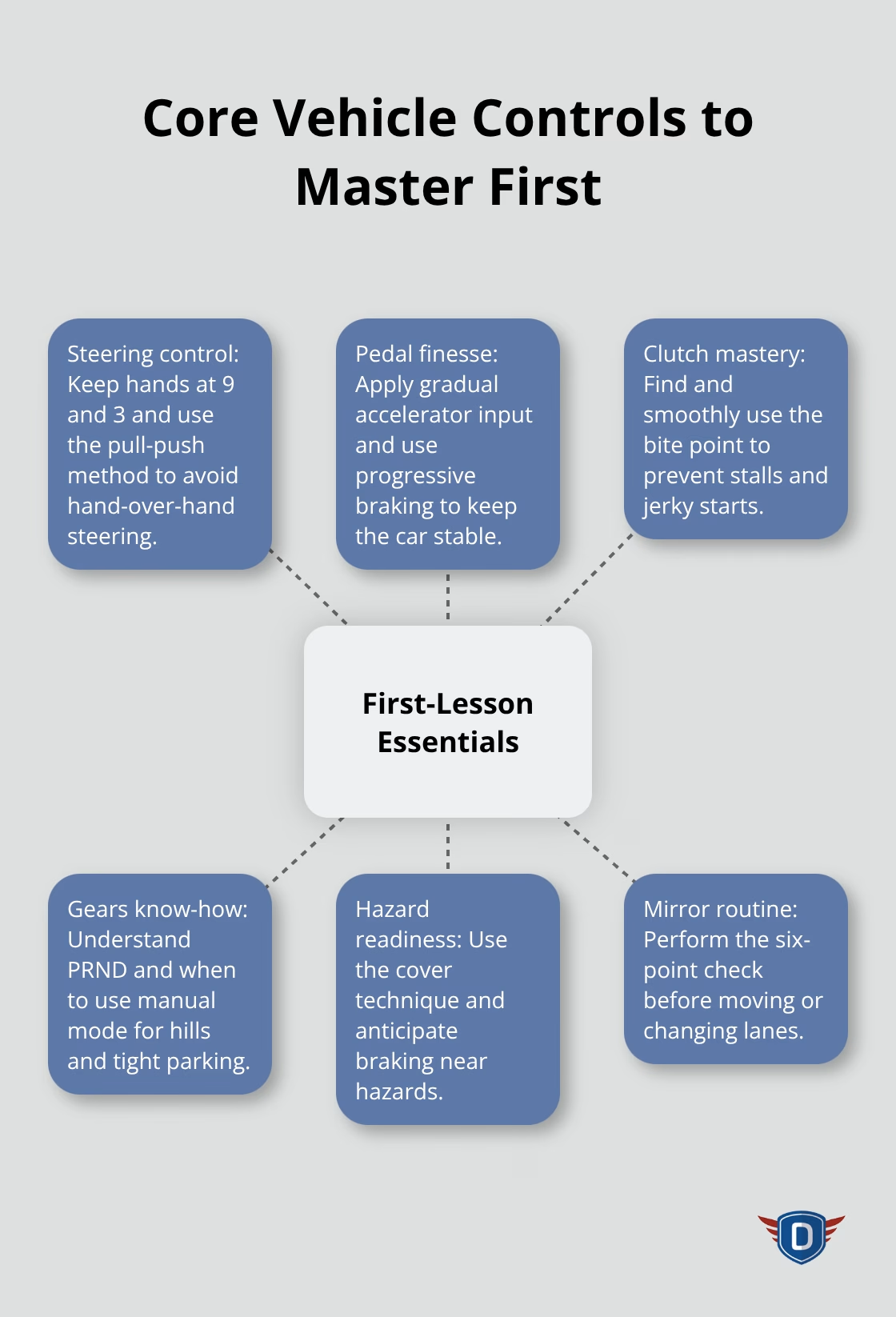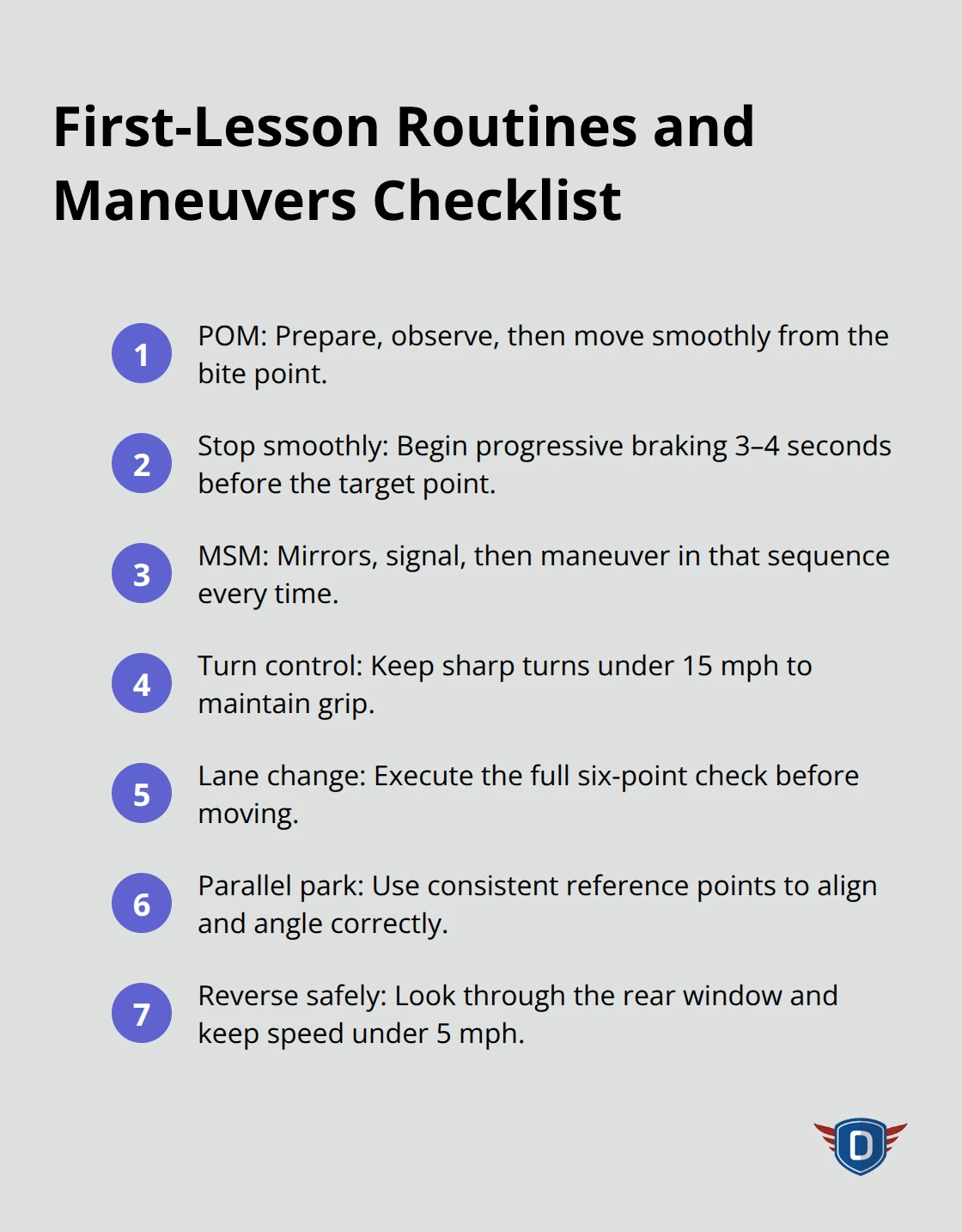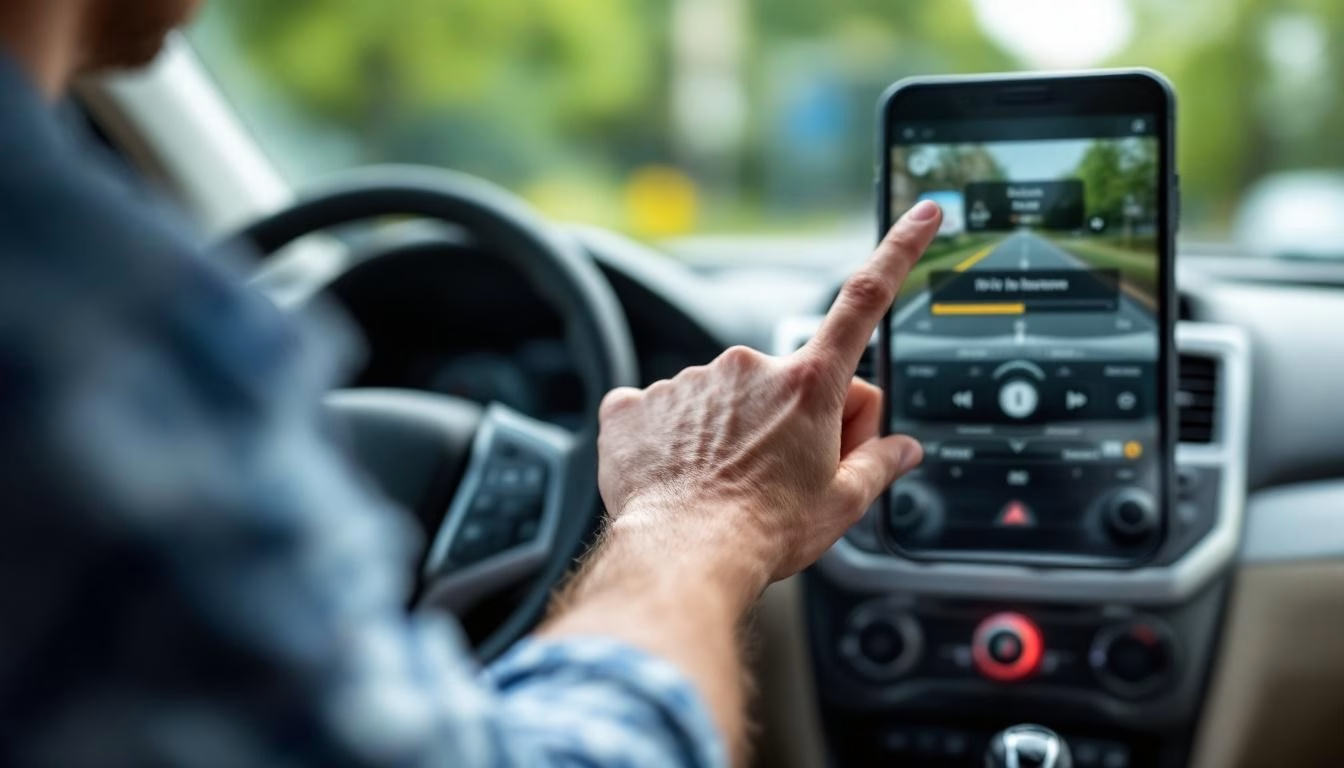Your first driving lesson can feel overwhelming, but mastering the basics sets you up for success. Most new drivers struggle with vehicle controls and basic maneuvers during their initial sessions.
We at floridadetscourse.com know that proper preparation and understanding fundamental techniques make all the difference. This guide covers the essential first driving lesson basics every beginner needs to know.
Essential Pre-Driving Preparations
Vehicle Safety and Control Check
The cockpit drill forms the foundation of safe driving and takes just 90 seconds to complete properly. Start with the DSSSM method: check all doors close securely, adjust your seat position, set the steering wheel height, fasten your seatbelt, and position all mirrors correctly. The CDC reports that seatbelt use reduces death risk by 45% in passenger vehicles (making this step non-negotiable). Your instructor should walk around the vehicle with you, check tire pressure, fluid levels, and exterior lights before any drive begins. This routine builds muscle memory that prevents accidents later.
Seat and Mirror Position for Maximum Control
Position your seat so your knees bend slightly when you press pedals fully, and your wrists rest on top of the steering wheel when you extend your arms. Your mirrors need precise adjustment: the rearview mirror should frame the entire rear window, while side mirrors should show just a sliver of your car’s body and mostly the road behind. The six-point check becomes automatic when mirrors have correct positions – you scan left mirror, left blind spot, rearview mirror, right mirror, right blind spot, then straight ahead before you move. Poor mirror position causes lane-change accidents, with studies showing that only 24% of unplanned lane changes use turn signals properly.

Dashboard Indicators and Warning Systems
Modern vehicles display 15-20 different warning lights, and you must recognize them to prevent breakdowns and accidents. Focus on the critical ones first: engine temperature, oil pressure, brake system warning, and turn signal indicators. The fuel gauge and speedometer require constant attention – speed-related crashes account for nearly one-third of all traffic fatalities per NHTSA statistics. Your instructor should explain each dashboard symbol during your first driving lesson (particularly the handbrake indicator and gear position display). Master these systems before you drive to prevent dangerous situations and build confidence behind the wheel. These fundamentals prepare you to handle the actual vehicle controls with precision and safety.
Basic Vehicle Controls and Operations
Steering Wheel Hand Position and Grip
The pull-push steering method provides maximum control and prevents the dangerous habit of hand-over-hand steering that causes accidents during emergency maneuvers. Place your hands at the 9 and 3 o’clock positions on the steering wheel, never at 10 and 2 which puts your arms at risk during airbag deployment. Your grip should be firm but relaxed – white knuckles indicate tension that leads to jerky movements and passenger discomfort. When you turn, push the wheel up with one hand while you pull down with the other, and keep both hands on the wheel at all times. This technique maintains precise control during sharp turns and prevents the wheel from slipping through your fingers during sudden corrections.

Pedal Control and Smooth Operation
Your right foot controls both the accelerator and brake pedal, while your left foot operates the clutch in manual vehicles. Position the ball of your foot on the pedals, not your toes or heel, to maintain consistent pressure and prevent sudden jerky movements. The accelerator requires gradual pressure – most new drivers press too hard initially, which causes the vehicle to lurch forward unpredictably. Brake pedal technique involves progressive pressure: apply light pressure first, then increase gradually to avoid passenger whiplash and maintain vehicle stability. Professional instructors teach the cover technique where you hover your foot over the brake pedal when you approach hazards.
Gear Changes and Clutch Coordination
Manual transmission requires precise clutch control to prevent stalls and gear damage that costs hundreds in repairs. Find the bite point when you slowly release the clutch until the engine note changes and the vehicle starts to move forward slightly. This friction point varies between vehicles, so practice to find it quickly during your first lesson. The clutch pedal should be pressed fully to the floor during gear changes, and released smoothly to avoid jerky acceleration. Automatic transmission students still need to understand gear positions: Park, Reverse, Neutral, and Drive, plus when to use manual mode for better control on hills and during park maneuvers.
These fundamental control skills prepare you to execute the basic maneuvers that form the core of safe street navigation and vehicle control techniques.
Fundamental Driving Maneuvers for Beginners
Starting and Stopping Without Jerky Movements
The POM routine – Prepare, Observe, Move – prevents the stalls and lurches that plague new drivers. Press the clutch fully, select first gear, find the bite point where the engine note changes, then release the handbrake while you gradually lift the clutch and apply gentle accelerator pressure. The vehicle should move forward smoothly without engine stall or sudden acceleration.
Stop with progressive brake pressure that starts 3-4 seconds before your target point. Press the clutch just before you stop completely, and apply the handbrake once stationary. Most new drivers brake too harshly or too late, which causes passenger discomfort and loss of vehicle control.

Safe Turn Execution and Lane Changes
The MSM routine – Mirrors, Signal, Manoeuvre – must happen in exact sequence during every turn and lane change to prevent accidents that occur when drivers skip steps. Check your mirrors first, signal your intention at least 100 feet before the turn, then execute the maneuver while you maintain appropriate speed.
Sharp turns require speeds below 15 mph to maintain tire grip and vehicle stability, while gentle curves allow higher speeds. Lane changes demand the six-point check: left mirror, left blind spot, rearview mirror, right mirror, right blind spot, then forward vision before you move. Improper lane changes cause significant accidents annually, mostly from drivers failing to check blind spots when changing lanes to pass slower vehicles.
Parking and Reversing Fundamentals
Parallel parking success depends on reference points that create consistent results every time you practice. Position your vehicle alongside the front car with mirrors aligned, reverse while you turn the wheel fully right until your passenger mirror shows the rear car’s headlights, straighten the wheel and reverse until your vehicle reaches a 45-degree angle, then turn the wheel fully left to slide into the space.
Reference points eliminate guesswork and reduce the multiple attempts drivers typically need to park successfully. Reverse maneuvers require constant head movement to scan all directions – your mirrors show limited views that miss pedestrians and low obstacles. Turn your body to look through the rear window during reverse movements, and use light accelerator pressure to maintain precise speed control below 5 mph (which prevents property damage and accidents).
Final Thoughts
First driving lesson basics demand focused attention on vehicle preparation, control techniques, and fundamental maneuvers. The DSSSM cockpit drill, proper hand position at 9 and 3 on the wheel, and progressive pedal control create the foundation of safe habits. These skills prevent common mistakes that cause accidents and build confidence for independent operation.
Regular practice transforms these techniques into automatic responses that serve drivers throughout their lifetime. The DVSA reports that average learners need 47 hours of professional instruction plus 20 hours of private practice to pass their test (with consistent repetition of mirror checks and proper procedures). Smooth acceleration and correct turns become muscle memory through dedicated practice sessions.
Professional instruction accelerates skill development and prevents dangerous habits that plague self-taught drivers. We at floridadetscourse.com offer comprehensive programs with certified instructors who provide personalized guidance. Expert instruction helps students master necessary skills faster than independent practice alone.







